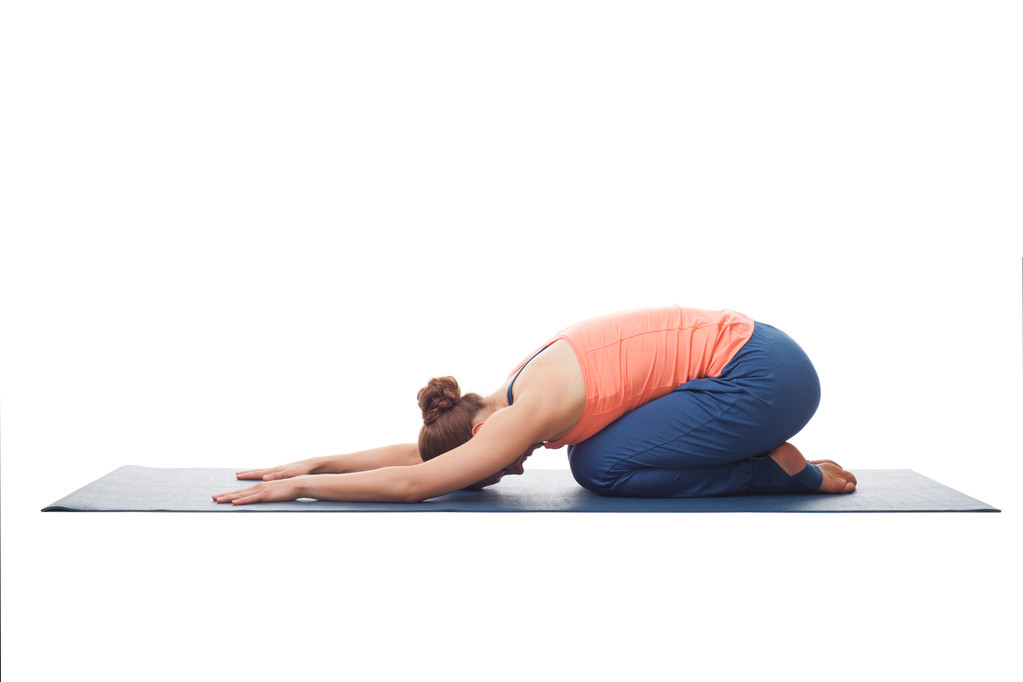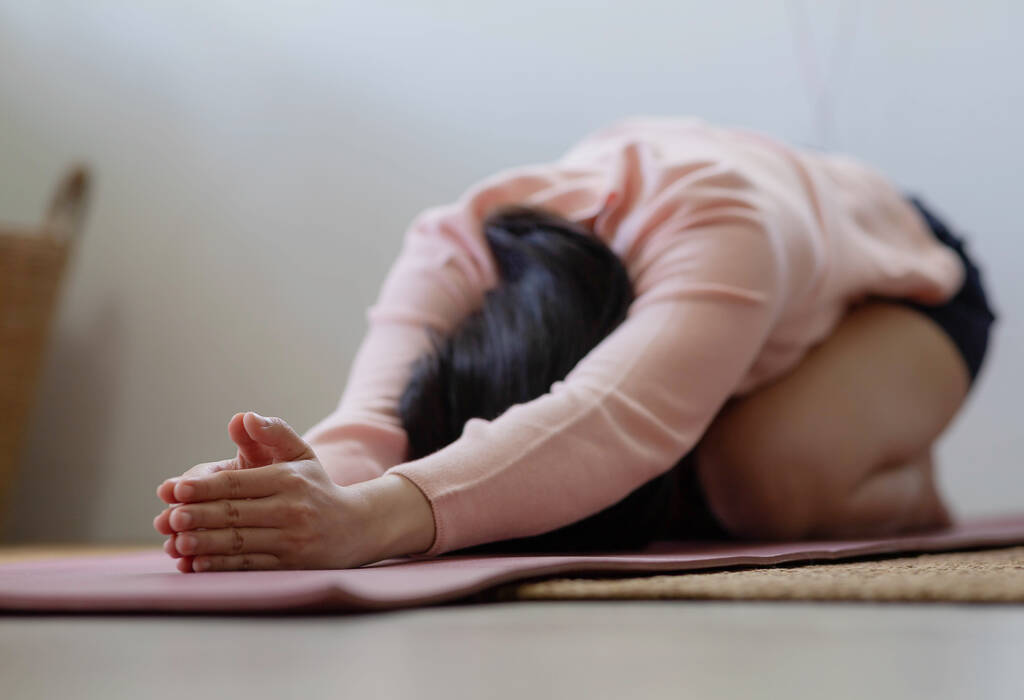Discover how to effectively use the Child’s Pose to relieve and release tension in your back.
How to Use the Child’s Pose to Alleviate Back Tension
Welcome to the world of yoga, where ancient practices meet modern lifestyles. In this article, we will explore the wonderful benefits of the Child’s Pose and how it can help alleviate back tension. So, roll out your yoga mat and get ready to embrace your inner child!

Understanding the Child’s Pose
Before diving into the technicalities, let’s take a moment to understand the essence of the Child’s Pose. This humble posture has a rich history and philosophy behind it.
The Child’s Pose, or Balasana as it’s known in Sanskrit, is inspired by the natural resting position of a child. It is a posture of surrender and tranquility, symbolizing a return to innocence and inner peace.
When you settle into this pose, imagine all your worries melting away, as you reconnect with your breath and your body.
The Child’s Pose has been practiced for centuries, originating in ancient India. It is deeply rooted in the philosophy of yoga, which emphasizes the union of mind, body, and spirit. This pose embodies the idea of surrendering and letting go, allowing oneself to be fully present in the moment.
As you sink into the Child’s Pose, you may feel a sense of grounding and stability. The gentle pressure of your forehead on the mat creates a connection with the earth, promoting a feeling of rootedness and stability.
Origins and Philosophy of the Child’s Pose
The Child’s Pose, or Balasana, is not just a physical posture; it carries a deeper meaning. It represents a return to simplicity and a reminder to embrace the childlike qualities within us. Just as a child finds comfort and security in curling up, this pose invites us to find solace and peace in our own bodies.
When you practice the Child’s Pose, you are encouraged to let go of any tension or stress, allowing yourself to be fully present in the moment. It is a moment of surrender, where you release the need to control and simply allow yourself to be.
As you settle into the pose, take a moment to reflect on the innocence and purity of a child’s heart. Allow yourself to tap into that sense of wonder and curiosity, embracing the simplicity and joy that comes with it.
Anatomy of the Child’s Pose
Now, let’s explore the inner workings of this beautiful pose. The Child’s Pose primarily targets the muscles of your back, hips, and thighs. It gently stretches the spine, releasing tension and promoting flexibility.
As you fold forward, your abdomen rests on your thighs, encouraging a gentle massage to your internal organs. This rejuvenating posture also aids in digestion and provides a moment of respite for your mind.
In addition to its physical benefits, the Child’s Pose also has a profound effect on your mental and emotional well-being. As you surrender into the pose, you may feel a sense of release and relief, as if a weight has been lifted off your shoulders.
This pose offers an opportunity to turn inward and connect with your breath. As you breathe deeply in this position, you may notice a calming effect on your nervous system, helping to reduce stress and anxiety.
As you hold the Child’s Pose, allow yourself to fully surrender and let go. Embrace the stillness and quietude that this pose offers, allowing yourself to find peace and serenity within.
The Connection Between Child’s Pose and Back Tension
Now that we have a solid foundation, let’s delve into how the Child’s Pose specifically targets and alleviates back tension.
How Yoga Affects the Back
Yoga is a magical practice that not only strengthens our bodies but also calms our minds. When it comes to back tension, yoga works wonders by gently stretching and strengthening the muscles and releasing built-up stress.
Regular practice helps improve posture, increase blood flow, and reduce inflammation, all of which contribute to a happier back.
But let’s zoom in on one particular yoga pose that is known for its incredible benefits for back tension: the Child’s Pose.
Specific Benefits of Child’s Pose for Back Tension
The Child’s Pose is like a magic potion for your back. It provides a gentle stretch to your spine, releasing tension from your lower back and promoting relaxation. With consistent practice, you can say goodbye to the stiffness and tightness that often plague the back.
But how exactly does the Child’s Pose work its wonders? Let’s break it down.
Firstly, when you settle into the Child’s Pose, your body naturally folds forward, allowing your spine to lengthen and decompress. This elongation of the spine helps to relieve any compression or tightness that may be causing back tension.
Secondly, the Child’s Pose gently stretches the muscles of the lower back, including the erector spinae and quadratus lumborum. These muscles often become tight and strained due to prolonged sitting or poor posture. By stretching them in the Child’s Pose, you can release any accumulated tension and promote flexibility in the back.
Additionally, the Child’s Pose stimulates the parasympathetic nervous system, which is responsible for the body’s rest and digest response. This activation of the parasympathetic nervous system promotes a sense of calm and relaxation, reducing the effects of stress on your body. As we all know, stress can manifest in the form of muscle tension, including back tension. By practicing the Child’s Pose regularly, you can counteract the negative effects of stress and create a more harmonious relationship between your mind and body.
So, the next time you feel that familiar ache in your back, remember the power of the Child’s Pose. Incorporate it into your yoga practice and experience the incredible benefits it offers for relieving back tension. Your back will thank you!
Preparing for the Child’s Pose
Before diving headfirst into this heavenly pose, let’s go over some important preparatory steps to ensure a safe and comfortable experience.
The Child’s Pose, also known as Balasana in Sanskrit, is a gentle and restorative yoga pose that is often practiced as a resting position during a yoga class or as a way to calm the mind and relax the body. It is a simple yet powerful pose that offers numerous benefits for both the physical and mental well-being.
Necessary Equipment and Space
One of the beautiful things about the Child’s Pose is that it requires minimal equipment. All you need is a yoga mat or a soft surface to rest on. The mat provides a comfortable and supportive foundation for your body, allowing you to fully surrender into the pose.
When choosing a yoga mat, opt for one that is thick enough to cushion your knees and ankles, providing extra support and comfort. A non-slip surface is also beneficial to ensure stability and prevent any accidental slips or falls.
Find a quiet and peaceful space where you can fully immerse yourself in the practice. It could be a dedicated yoga room, a corner of your living room, or even a serene outdoor setting. Creating a tranquil environment helps to enhance the overall experience and allows you to connect more deeply with your breath and body.
Safety Precautions and Contraindications
As with any physical activity, it’s essential to listen to your body and practice with caution. While the Child’s Pose is generally safe for most individuals, there are a few precautions and contraindications to keep in mind.
If you have any specific medical conditions, such as knee injuries, ankle injuries, or pregnancy, it would be wise to consult with a healthcare professional or a qualified yoga instructor before attempting this pose. They can provide personalized guidance and modifications to ensure your safety and comfort.
For individuals with knee injuries, placing a folded blanket or bolster under the knees can help alleviate any discomfort or pressure on the joints. Pregnant individuals can modify the pose by widening their knees and placing a bolster or blanket between the thighs for support.
Remember, yoga is a personal journey, and modifications are always available to suit your unique needs. It’s important to honor your body’s limitations and not push yourself beyond what feels comfortable. By practicing mindfully and with awareness, you can experience the full benefits of the Child’s Pose while keeping yourself safe and injury-free.
Step-by-Step Guide to Performing the Child’s Pose
Now that we’ve covered the basics, let’s dive into the nitty-gritty of performing the Child’s Pose. Follow these simple steps to embrace the full experience.
Entering the Pose
Start by kneeling on your yoga mat, with your big toes touching and your knees hip-width apart. Take a deep breath in and as you exhale, slowly lower your torso down to rest it between your thighs. Let your forehead rest on the mat and extend your arms forward, palms facing down.
Allow your body to relax and surrender to the gentle stretch.
Holding the Pose
Once you settle into the Child’s Pose, surrender your weight to the earth and take deep, mindful breaths. Stay in this pose for about 5-10 breaths, or for however long feels comfortable for you. As you inhale, feel the expansion in your back, and as you exhale, imagine tension dissipating with each breath.
Allow your body and mind to soak in the rejuvenating benefits.
Exiting the Pose
When you’re ready to release the pose, slowly and mindfully walk your hands back towards your body, lifting your torso up, vertebrae by vertebrae. Take a few moments to sit in a comfortable seated position, allowing the effects of the pose to settle in.
Incorporating Child’s Pose into Your Routine
Now that you’ve mastered the Child’s Pose, let’s explore how you can incorporate it into your daily routine to maximize its benefits.

Best Times to Practice Child’s Pose
The beauty of the Child’s Pose is its versatility. You can practice it at any time of the day to experience its soothing effects. Many practitioners find it beneficial to start their day with this pose to set a calm and centered tone.
Additionally, the Child’s Pose can be a great companion during a busy day, providing a quick break to recharge and reset.
Combining Child’s Pose with Other Yoga Poses
If you’re feeling adventurous, consider weaving the Child’s Pose into your yoga flow. It serves as a gentle transition between more dynamic poses, allowing you to find balance and regain your breath. Some popular sequences include Child’s Pose to Downward Facing Dog or Child’s Pose to Cat-Cow Pose.
Get creative and build your own unique flow, keeping the Child’s Pose as your trusty anchor.
So there you have it – the Child’s Pose, a nurturing posture that offers so much for your mind, body, and soul. Embrace the simplicity and power of this pose, and let it be your sanctuary from the stresses of modern life. Give it a try, and who knows, you might just find yourself feeling lighter, more centered, and ready to conquer the world!



